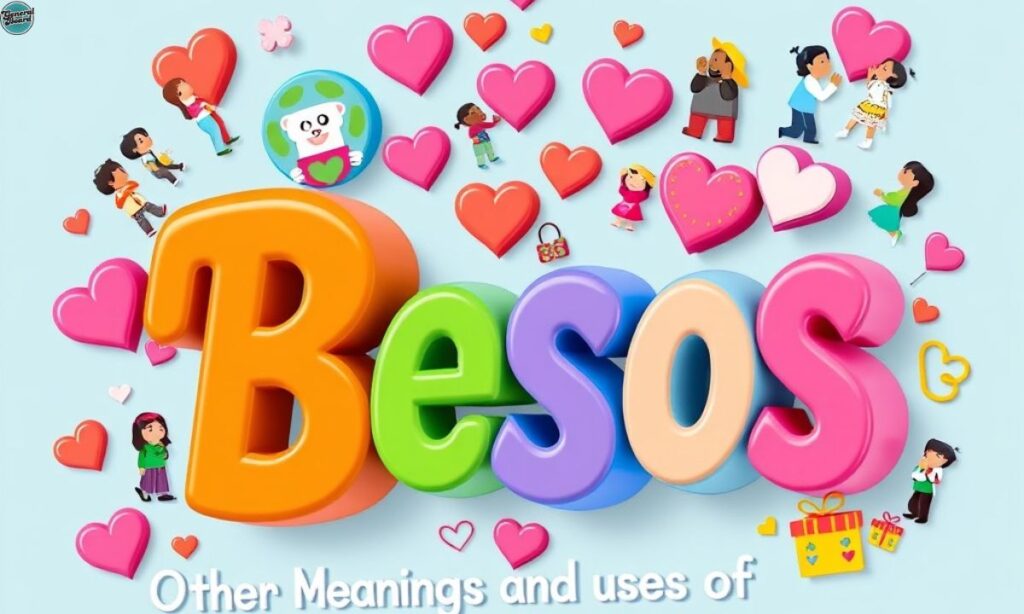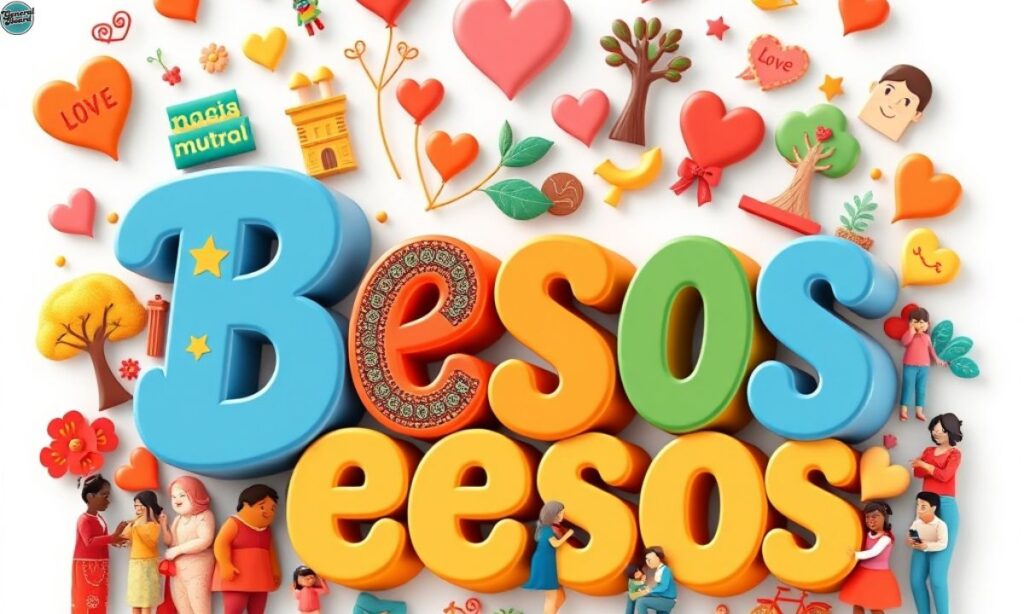“Besos” is the Spanish word for “kisses,” commonly used to express affection, love, or endearment in both spoken and written communication. Its usage spans casual conversations among friends to romantic exchanges between partners. This simple yet powerful word carries emotional weight, often closing messages with warmth and intimacy. Its versatility makes it a staple in Spanish-speaking cultures and beyond.
Exploring the origins and cultural impact of “besos” reveals its deep roots in Latin languages and its widespread influence in global media, music, and art. Beyond its literal meaning, it reflects social norms, emotional expression, and the value of connection in various communities. From heartfelt goodbyes to passionate love songs, “besos” serves as a universal symbol of human affection and closeness.
What Does “Besos” Mean?
“Besos” is the Spanish word for “kisses” in its plural form, used to convey affection, love, or tenderness. It’s a warm expression commonly used in both spoken and written communication.
While often used in romantic contexts, “besos” can also be exchanged among friends and family as a sign of care or closeness. It adds a personal, emotional touch to everyday interactions.
In digital communication—texts, emails, and social media—“besos” is frequently used to sign off messages warmly. It functions similarly to “hugs and kisses” in English, often appearing as “besos y abrazos.”
The Origin and Evolution of “Besos”
“Besos” derives from the Spanish verb besar (“to kiss”), which has roots in the Latin word basiare. Latin, the foundation of Romance languages, passed this affectionate term down through centuries.
As Spanish spread globally through colonization and cultural exchange, the word “besos” became embedded in many Spanish-speaking societies. Its meaning remained consistent, symbolizing love and affection.
Today, “besos” has adapted to modern forms of expression—from love songs and poetry to emojis and hashtags. Despite changing communication styles, its emotional resonance remains strong across cultures.
Is “Besos” Slang, Acronym, or a Name?
- “Besos” is not slang—it is a standard Spanish word meaning “kisses.”
- It is commonly used in casual and formal contexts to express affection.
- “Besos” is not an acronym; it doesn’t stand for anything—it’s a full word with its own meaning.
- In modern digital communication, it may feel informal, but it retains its literal meaning.
- The word is widely used across Spanish-speaking countries, from Spain to Latin America.
- “Besos” can sometimes appear in English conversations among bilingual speakers for flair or emotion.
- While not typically a name, “Besos” has been used artistically—for example, in song titles or business names.
- Overall, “besos” is a proper Spanish noun, not categorized as slang, acronym, or a personal name in standard use.
Pronunciation and Spelling of “Besos”
- “Besos” is pronounced as [BEH-sos] in Spanish, with stress on the first syllable.
- The “b” sounds like a soft ‘b’, close to a blend of ‘b’ and ‘v’ in many dialects.
- The “e” is pronounced like the short ‘e’ in “bed”, not like the English “bee.”
- The “s” is clear and unvoiced, similar to the English “s” in “sun.”
- The “o” is a pure vowel, pronounced like the “o” in “soft.”
- There is no silent letter; it’s spelled exactly as it sounds: B-E-S-O-S.
- The plural “-s” at the end is pronounced clearly, indicating more than one kiss.
- Non-Spanish speakers often mispronounce it as “bee-sos,” but the correct pronunciation is “beh-sos.”
How People Use “Besos” Today
Today, “besos” is commonly used in text messages, emails, and social media to end conversations on a warm, affectionate note. It’s a popular sign-off among friends, family, and romantic partners.
People often pair “besos” with “abrazos” (hugs) to say “besos y abrazos,” which expresses both emotional warmth and physical closeness. It’s a comforting phrase used in both happy and supportive contexts.
In pop culture, “besos” appears in song lyrics, captions, and hashtags to convey love or flirtation. Its frequent use reflects the global influence of Spanish expressions in modern communication.
Examples of “Besos” in Sentences
- ¡Te extraño mucho! Besos.
(I miss you so much! Kisses.) - Gracias por el regalo, fue hermoso. Besos y abrazos.
(Thank you for the gift, it was beautiful. Hugs and kisses.) - Nos vemos pronto, besos.
(See you soon, kisses.) - Mándale muchos besos a tu mamá de mi parte.
(Send lots of kisses to your mom from me.) - Besos desde España, ¡cuídate mucho!
(Kisses from Spain, take good care!) - Recibí tu carta y me encantó. ¡Mil besos!
(I received your letter and loved it. A thousand kisses!) - Te envío besos virtuales.
(Sending you virtual kisses.) - Ella terminó la llamada diciendo ‘besos, te quiero’.
(She ended the call saying ‘kisses, I love you’.)
Other Meanings and Uses of “Besos”

Beyond its literal meaning of “kisses,” “besos” is often used figuratively to convey warmth, kindness, or emotional support. It can soften a message or add a caring tone, even in non-romantic contexts.
“Besos” is also used in pop culture—appearing in song titles, brand names, and artistic works to evoke romance or tenderness. In some regions, it can refer to desserts or candies shaped like kisses, showing its versatility in language and culture.
Related Words and Common Phrases
- Besos y abrazos – Kisses and hugs
A popular phrase used to end messages warmly, expressing affection and closeness. - Te mando besos – I’m sending you kisses
A sweet and caring phrase often used in texts, letters, or calls to express love or affection. - Un beso grande – A big kiss
Used to emphasize affection, commonly said when parting from someone you care about. - Con todo mi cariño – With all my affection
A tender phrase often used with “besos” in heartfelt messages or letters. - Mil besos – A thousand kisses
An exaggerated, affectionate way of saying you care deeply, often used in romantic or very close relationships.
Is “Besos” in the Dictionary?
Yes, “besos” is in the dictionary as the plural form of the Spanish noun beso, meaning “kiss.” It appears in all major Spanish dictionaries, including the Diccionario de la lengua española by the Royal Spanish Academy. Its definition is straightforward, referring to the act of kissing or expressions of affection.
Better Alternatives to “Besos”
- Abrazos – Means “hugs,” often paired with or used instead of kisses to show warmth.
- Con cariño – Translates to “with affection,” a gentle way to close messages.
- Cariños – Means “affection” or “love,” used as a sweet sign-off.
- Un abrazo fuerte – Means “a big hug,” conveying strong emotional support.
- Con amor – “With love,” a heartfelt and sincere alternative.
- Cuídate mucho – Means “take good care,” showing concern and care.
- Con todo mi cariño – “With all my affection,” an affectionate and warm phrase.
- Te quiero mucho – “I love you very much,” more direct and emotional than just “besos.”
Cultural and Generational Impact of “Besos”

“Besos” holds a significant place in Hispanic culture as a common way to express affection and connection. Across generations, it serves as both a linguistic and emotional bridge, passed down from elders to younger family members.
While older generations may use “besos” more formally in letters and face-to-face farewells, younger people often incorporate it into digital communication, blending tradition with modern expression. This keeps the word alive and relevant across ages.
READ THIS BLOG: 425+ Top Body Swap Captions
The Future of “Besos”
As digital communication evolves, “besos” is likely to remain a popular sign-off, adapting to new platforms like emojis, gifs, and voice messages. Its emotional warmth ensures it won’t fade away anytime soon.
The global influence of Spanish language and culture may also expand the use of “besos” beyond Spanish-speaking communities. It’s poised to become a universal symbol of affection in an increasingly connected world.
Frequently Asked Questions
What does “besos” mean in English?
“Besos” means “kisses” in English.
How do you pronounce “besos”?
“Besos” is pronounced as ‘BEH-sos’, with the stress on the first syllable.
Is “besos” appropriate in formal settings?
“Besos” is usually informal and more suitable for personal or casual communication.
Can non-Spanish speakers use “besos”?
Yes, non-Spanish speakers often use “besos” to add warmth or cultural flair in messages.
What’s the difference between “beso” and “besos”?
“Beso” is singular, meaning “kiss,” while “besos” is plural, meaning “kisses.”
Conclusion
The word “besos” carries much more than its literal meaning of “kisses”; it embodies affection, connection, and warmth across Spanish-speaking cultures. Its rich history, rooted in Latin, shows how language evolves while preserving deep emotional expressions. Whether used in personal letters, digital messages, or artistic works, “besos” remains a timeless symbol of love and closeness.
As society and communication styles continue to change, “besos” adapts seamlessly, bridging generations and cultures. Its cultural impact extends beyond language, influencing music, art, and everyday interactions worldwide. Ultimately, “besos” is more than a word—it’s a heartfelt gesture that resonates universally, making it an enduring and meaningful part of human connection.